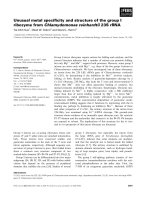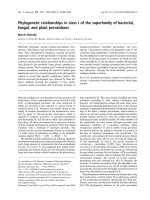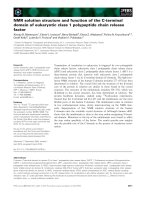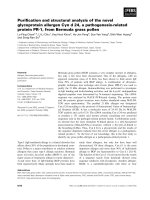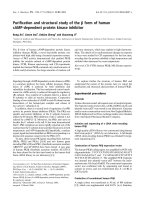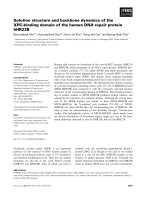Báo cáo khoa học: "Bench-to-bedside review: Routine postoperative use of the nasogastric tube – utility or futility" pptx
Bạn đang xem bản rút gọn của tài liệu. Xem và tải ngay bản đầy đủ của tài liệu tại đây (643.17 KB, 7 trang )
Page 1 of 7
(page number not for citation purposes)
Available online />Abstract
This article provides a summary of current information on rational
postoperative use of the nasogastric tube, based on a review of
literature related to postoperative gastrointestinal discomfort and
management with the nasogastric tube. Routine gastric
decompression after major surgery neither hastens the return of
bowel function nor diminishes the incidence of postoperative
nausea and vomiting. The multimodal postoperative rehabilitation
programme is a modern and more efficient approach. Omission of
nasogastric tube decompression does not increase the incidence
of anastomotic leakage or wound dehiscence. Conversely, early
enteral feeding is feasible and safe, favours local immunity and gut
integrity, and improves nutritional status. With the objective to
feeding, nasogastric tube could be used in selected patients. To
conclude, use of the nasogastric tube to prevent or limit
postoperative gastrointestinal discomfort must be challenged. In
contrast to gastric decompression, early gastric feeding must be
considered within the new concept of fast track surgery.
Introduction
Since the 1930s routine use of the nasogastric tube to
achieve postoperative gastric decompression has enjoyed
widespread acceptance, and for decades patients’ complaints
were not taken into consideration by anaesthesiologists and
surgeons. This strong consensus was based on a traditionally
held view, namely that postoperative ileus (POI) should be
reduced by nasogastric decompression, although the different
specialities had their own reasons to endorse this approach.
Anaesthesiologists were mainly concerned with postoperative
nausea and vomiting (PONV), whereas surgeons were
concerned with preventing wound dehiscence, incisional
hernia and anastomotic leakage. It is possible that we have
forgotten that the history of the tube began as early as 1790,
when it was used to feed and not to decompress, and we
must reconsider the role of the nasogastric tube during the
postoperative period.
Postoperative gastrointestinal discomfort
Postoperative gastrointestinal discomfort is not new. The
earliest written records described an unchanging physio-
logical response following any type of surgery, with greater
severity after laparotomy. Clinically, there are three typical
consequences of surgery, namely dilatation of the stomach,
ileus and PONV.
Dilatation of the stomach is related to the common
postoperative increase in swallowing [1]. Air carried into the
stomach with each swallow induces gastric discomfort, and
when present in great quantities the air passes into the
intestine, resulting in abdominal distension. The greatest
incidences were found in patients who had undergone surgery
to the biliary tract or uterus and adnexa. In the majority of the
cases, distension was apparent after 24 hours and the usual
duration was 48 to 72 hours [2]. Decompression relieves
gastric discomfort, but the irritating presence of the tube
promotes swallowing. In any case, these physio-logical events
must be distinguished from acute gastric dilatation and acute
colonic pseudo-obstruction, which are responsible for major
abdominal distension in very specific circumstances.
In reality, common postoperative gastrointestinal discomfort
results predominantly from ileus, and nausea and vomiting.
Wells and coworkers [3] stated that, ‘After any abdominal
operation it is usual for intestinal movements to cease for a
time and then to return gradually. This POI usually lasts for up
to 48 hours, its duration being related to the amount of
intestinal handling at the operation. This period of inactivity of
the intestine is presumed to be the response of the intestine
to the various surgical manipulations. It is easily recognised
clinically because the abdomen is silent when auscultated but
is not induly distended.’ This assertion, from 1964, has not
been challenged since. It became dogma, with universal
Review
Bench-to-bedside review: Routine postoperative use of the
nasogastric tube – utility or futility?
Michèle Tanguy, Philippe Seguin and Yannick Mallédant
Service d’Anesthésie Réanimation 1, Hôpital de Pontchaillou, rue Henri le Guilloux, 35033 Rennes Cedex 9, France
Correspondence: Yannick Mallédant,
Published: 4 January 2007 Critical Care 2007, 11:201 (doi:10.1186/cc5118)
This article is online at />© 2007 BioMed Central Ltd
POI = postoperative ileus; PONV = postoperative nasea and vomiting.
Page 2 of 7
(page number not for citation purposes)
Critical Care Vol 11 No 1 Tanguy et al.
agreement that ileus should be countered by some form of
gastrointestinal suctioning. All patients who underwent
surgery of the gastrointestinal tract underwent placement of a
nasogastric tube, with various criteria for removal such as
normal bowel sounds heard by the surgeon or passage of
flatus or stool. Its perceived importance in earlier years was
well expressed by WJ Mayo: ‘Would rather have a resident
with a nasogastric tube in his pocket than a stethoscope.’ In
this context, gastric decompression was also recommended
for the prevention of incisional hernia, wound dehiscence and
anastomotic leak. This practice was extended to several other
types of surgery, abdominal or otherwise, as secondary
indications.
The medical impact of PONV is minor but it clearly is to the
detriment of patient comfort. Surgical patients who
experienced PONV were willing to pay up to US$100 for a
completely effective antiemetic [4]. For the past 40 years, the
incidence of PONV has remained constant, involving 20% to
30% of surgical patients. The incidence of nausea is nearly
20% in the postanaesthetic care unit and is over 50% after
24 hours, with corresponding numbers for vomiting being 5%
and 25%, respectively. Nausea, retching and vomiting are
often analyzed simultaneously and traditionally are related to
delayed gastric emptying; however, they are distinct
phenomena. In this context, nasogastric decompression was
believed to be a logical alternative to prokinetic agents.
Routine nasogastric decompression:
an inappropriate measure
Common postoperative ileus is basically a colonic
phenomenon
Several animal models have been established to investigate
mechanisms of ileus, and the descriptions are consistent
[5-8]. Stomach emptying is impaired for about 24 hours
after laparotomy. In contrast, the motility and the capacity of
absorption of the small intestine is normal within a few
hours after surgery. The small bowel, although mobile,
contains little fluid or gas and therefore does not generate
bowel sounds until the stomach resumes activity after
24 hours, pushing swallowed air and fluid into the gut. Any
gas that reaches the small intestine is rapidly passed on
into the caecum. However, the colon remains inert for a
long time, with differences in times needed for return of
activity in caecum (48 hours) and sigmoid colon (72 hours),
with the passage of flatus or stool as a marker. Evidently,
the profound change in colon motility is a major feature of
the postoperative abdomen. It results from differences
between the mobility of the ileum and the inertia of the
rectosigmoid [9]. The autonomic nervous system
undoubtedly plays an important role in POI, with peri-
operative stimuli inducing an increase in tonic inhibitory
sympathetic control, as indicated by the inhibition of bowel
function that occurs following surgery not involving the
peritoneum. For instance, hip surgery is frequently asso-
ciated with severe ileus [7].
Postoperative paralytic ileus is a consequence of local
factors
Occasionally, ileus is prolonged for days or weeks and is
described as postoperative paralytic ileus. The distinction
between common POI and postoperative paralytic ileus is
important because these phenomena probably result from
different pathogenic mechanisms (Figure 1). Indeed, post-
operative paralytic ileus affects all segments of the bowel and
probably is the consequence of further inhibition of the local
intrinsic contractile system. Resulting from bowel manipula-
tion, hypoxia, endotoxin, or hypoperfusion, gut mucosal injury is
the initial step inducing local release of nonadrenergic, non-
cholinergic inhibitory neurotransmitters such as nitric oxide,
vasoactive intestinal peptide, substance P, calcitonin gene-
related peptide and prostanoids. Accordingly, a panel of
responses may be observed, related to the duration and type
of surgery and the degree of injury to the gut mucosa.
As a consequence, minimally invasive surgery could reduce
the inflammatory response. In this regard, open and laparo-
scopic procedures have been compared. Most studies inclu-
ded benign gynaecological disorders or cholecystolithiasis,
and a significantly more rapid resolution of ileus was reported
with laparoscopic procedures. In a recent meta-analysis
involving 6477 children undergoing appendicectomy [10],
ileus was significantly reduced with laparoscopic compared
with open procedures. However, these findings must be
interpreted with caution because laparoscopic procedures
are frequently viewed as benign by surgeons and patients,
and perioperative management may be simplified as a
consequence [11]. In a recent randomized trial [12],
laparoscopic colectomy was associated with a shorter delay
to first postoperative bowel movement but concurrently with
decreased need for opioid analgesics at days 2 and 3. There
is a lack of strong, unbiased evidence from human studies,
which has stimulated interest in animal models. In a canine
model, Davies and coworkers [13] compared three
procedures: open colectomy, total laparoscopic and
laparoscopically assisted colectomy. They demonstrated a
significantly earlier return of gastrointestinal function with a
total laparoscopic procedure, but these beneficial effects
were not observed with laparoscopically assisted colectomy.
Few studies have investigated the gastrointestinal impact of
strategies to protect gut blood flow. Gan and colleagues [14]
compared two modes of intraoperative fluid administration in
patients undergoing major elective general urological or
gynaecological surgery. Continuous intraoperative Doppler-
based estimation of ventricular preload to optimize fluid replace-
ment allowed a 48-hour improvement in resolution of ileus.
Pain and opioids increase the duration of ileus. The major
gastrointestinal impact of opioids is related to the µ
2
receptors that are present in the presynaptic nerve terminals
of the myenteric plexus. Both endogenous opioid peptides
and exogenously administered opioid analgesics affect a
Page 3 of 7
(page number not for citation purposes)
variety of gastrointestinal functions associated with motility,
secretion and visceral pain. Hence, achieving a balance
between pain control and abdominal discomfort is a challenge
in patients undergoing major surgery. Minimal use of opioid
analgesics is recommended, and epidural infusion of a local
anaesthetic has been advocated [15]. Epidural analgesia
blocks pain transmission through afferent nerve fibres,
reducing the need for postoperative opioids; it also inhibits
the sympathetic efferent nerves in the thoracolumbar region,
increasing gastrointestinal blood flow [16]. Furthermore,
efferent parasympathetic tone in the sacral region remains
unopposed, promoting gastrointestinal motility. Epidural
infusion of local anaesthetics has proved to be more efficient
than systemic or epidural opioid analgesia with regard to
postoperative recovery of colonic function. Accordingly, a
recent meta-analysis including a total of 406 patients [17]
found a 44-hour reduction in time to first passage of stool in
the group receiving local anaesthesia. Middle thoracic
epidural blockade is more consistently effective than a low
thoracic or lumbar level one [15]. Moreover, as a pain relief
regimen, the combination of epidural local anaesthetic and
opioid is not superior to local anaesthetic alone [18].
With the recent development of selective inhibition of gastro-
intestinal opioid receptors, a simple and appealing approach
that is free from the technical demands of thoracic epidural
infusion has emerged. Potent oral, peripherally acting
antagonists of gastrointestinal opioid receptors are poorly
absorbed following oral administration. In an exploratory trial,
Taguchi and coworkers [19] found a significantly accelerated
recovery of bowel function, without compromised control of
analgesia, in patients who underwent partial colectomy or
total abdominal hysterectomy. These data were partially
confirmed by a recent phase III trial [20], but a number of
questions were raised. The time to gastrointestinal recovery
was significantly accelerated only for those patients who
underwent bowel resection or radical hysterectomy. Further-
more, a clear dose response is not well established, and
other studies are needed before widespread use under
various postoperative circumstances can be advocated.
Incisional hernia, anastomotic leakage and wound
dehiscence are not consequences of ileus
An estimated 10% to 15% of patients undergoing laparotomy
incision eventually develop hernias [21]. Intuitively, elevated
intra-abdominal pressure was suggested as a risk factor. On
the other hand, important roles of surgical technique and
biological environment have been demonstrated [22-24].
Abdominal fascial closure of midline laparotomy wounds with
a continuous, nonabsorbable suture results in a significantly
lower rate of incisional hernia (32% risk reduction) compared
with use of either nonabsorbable or interrupted techniques.
The impact of biological environment on healing is currently
being investigated. Abdominal fascial closure of laparotomy
wounds when adjacent to a continuous-release
polygalactone polymer rod containing fibroblast growth factor
results in a drastic reduction (90% versus 30%) in incisional
hernias in animals [24].
Anastomotic leakage after visceral surgery is one of the most
important and feared complications. The incidence is 3% to
12%, and it is responsible for 30% of deaths following
Available online />Figure 1
Mechanisms of postoperative gastrointestinal discomfort.
colorectal surgery. As for incisional hernia, tension was
believed to be a risk factor, but no link has been demon-
strated and proximal decompression does not protect against
anastomotic disruption but only ameliorates its conse-
quences [25]. Reported aetiologic factors in anastomotic
failure include male sex, obesity, previous radiotherapy,
emergency procedure, low anastomosis, pelvic drainage and
transfusion. New concepts in the field of gastrointestinal
healing are currently being investigated. In a prospective
study involving patients with colorectal anastomosis, the
collagen I/III ratio and matrix metalloproteinase profiles of
colonic tissues were significantly different between patients
suffering anastomotic dehiscence and those with no
complications [26]. These data suggest that disturbance in
the extracellular matrix may play a role in the pathogenesis of
anastomotic leakage.
Postoperative nausea and vomiting are consequences
of individual factors
PONV and POI are distinct components of the patho-
physiological response to surgery. Regrettably, these entities
have been combined in studies conducted during recent
decades.
It is still poorly understood why some patients vomit after
surgery and others do not. However, it is well known that
individual factors as older age, female sex, being a non-
smoker, and history of PONV or motion sickness increase the
likelihood of PONV. Moreover, exogenous factors such as
omitting nitrous oxide, propofol administration, perioperative
use of supplemental oxygen, good intravenous hydration,
reduction in opioid use and neostigmine have been reported
to decrease the incidence of PONV [27,28]. The duration
and type of surgery are other risk factors, but their impact is
less marked. The individual risk factor approach has led to
formulation of risk scores and made preventative approaches
more efficient [29-32].
Impact of routine gastric decompression
Controversy concerning routine postoperative gastric suction
emerged as early as 1960 [33]. The suggested beneficial
effects were in opposition to the various complications of the
nasogastric tube, some of which were even suspected of
promoting ileus. The catalogue of possible complications is
impressive but not as disturbing as the discomfort it causes
to patients [34]. Most complications are related to naso-
pharyngeal insertion. Irritative rhinitis and pharyngitis are
uncomfortable and distressing to the patient [35]. As
mentioned above, the simple presence of a nasogastric tube
causes significant changes in swallowing behaviour, with
concomitant increase in gastric dilatation. A systematic
review of 20 clinical studies focusing on routine gastric
suction after elective laparotomy [36] demonstrated that
routinely decompressed patients suffered more pulmonary
complications. In a recent study [37] multivariate analysis
revealed that perioperative use of a nasogastric tube was the
major risk factor (odds ratio 7.7) for postoperative pulmonary
complications.
In the absence of gastric decompression there is a moderate
increase in vomiting. However, it is important to note that
routine nasogastric decompression does not prevent
vomiting in 10% of patients, and it does not preclude the
need for tube replacement once it has been removed. In fact,
for each patient not routinely decompressed who subse-
quently requires tube placement for nausea, vomiting, or
abdominal distension, at least 20 patients can be managed
without the tube [36]. A recent systematic review of prophy-
lactic nasogastric decompression after abdominal operations
[38] did not support a beneficial effect of the tube on various
aspects of gastric upset during the postoperative period, but
it identified more discomfort with routine use of the tube.
However, the great heterogeneity of studies does not allow a
summary statistic to be calculated. Hence, the hypothesis
that gastric decompression during and after surgery will
reduce the incidence of vomiting continues to be tested. In a
recent study conducted in patients undergoing cardiac
surgery with a high PONV score [39], perioperative use of
the nasogastric tube did not influence the incidence of
nausea, vomiting, or retching.
Nasogastric suction does not interfere with the
mechanisms underlying ileus. In a recent meta-analysis
[38], which included abdominal operations of any type,
emergency or elective, prophylactic nasogastric decom-
pression clearly did not hasten return of bowel function. On
the contrary, a significantly earlier return of bowel function -
as determined by the time to flatus - was observed without
use of the tube.
Clearly, avoidance of nasogastric decompression following
elective colorectal surgery does not affect the incidence of
anastomotic leakage or incisional hernia. In a prospective
study, Cunningham and coworkers [40] randomized 102
patients undergoing small or large bowel anastomosis to
either routine nasogastric decompression or no tube. No
significant differences in intestinal outcome were observed.
Confirmation was recently provided by the meta-analysis
conducted by Nelson and coworkers [38] in 2005. Similarly,
omission of routine nasogastric decompression after colo-
rectal surgery did not affect the incidence of incisional hernia
in a clinical study with 5 years of follow up [41].
Finally, the two meta-analyses conducted during two distinct
trial periods [36,38] clearly indicated that prophylactic use of
nasogastric decompression offers patients no benefit that
would offset the discomfort and potential morbidity
associated with its use (Figure 2). In all of the studies, at most
10% of patients who were not routinely decompressed
required insertion of a nasogastric tube postoperatively. Thus,
90% of patients would have been needlessly decompressed
if routine decompression had been used.
Critical Care Vol 11 No 1 Tanguy et al.
Page 4 of 7
(page number not for citation purposes)
Feeding or gastric decompression
In contrast to gastric decompression, early feeding has a
favourable effect on major outcomes [42-45]. Although there
is a significantly higher incidence of gastric or abdominal
distension, and nausea or vomiting, this is not associated with
any untoward outcome [46]. However, feeding induces
earlier resolution of ileus [47,48]. Moreover, with early eating,
the gastrointestinal tract gains advantages from saliva and
gastrointestinal secretions, which possess a multiplicity of
healing and antibacterial defence systems. The acidity of the
stomach prevents colonization of Gram-negative bacilli and
biliary secretions preserve balanced intestinal microflora.
Enteral nutrition has proved to protect against postoperative
sepsis by supporting mucosal immunity and to modulate the
progression from gut ischaemia to systemic inflammatory
response syndrome. Studies of animals exposed to brief
episodes of mesenteric ischaemia and reperfusion have
found that enteral feeding, as compared with parenteral
nutrition, reduced mortality rate, abnormal gastric motility and
organ permeability. Early oral nutrition reduces catabolism
and loss of lean body mass, and enhances visceral blood
supply to preserve the integrity of gut structure; hence, the
fear of anastomotic dehiscence with early oral nutrition is not
rational. In a systematic review of controlled trials, Lewis and
coworkers [42] reported a trend toward a reduction in
anastomotic dehiscence and wound infection with early
feeding.
The standard postoperative nutritional intervention consists of
a gradual reintroduction of an oral diet, as tolerated. This
sometimes results in several days of insufficient nutrient
intake and prolonged use of intravenous infusion. Many
perioperative circumstances may widen the gap between
requirements and intake. In a broad spectrum of surgical
patients, there is no absolute gastrointestinal failure but the
oral route is not an option. Typically, the problem emerges in
surgical patients who require a few days to wean from
mechanical ventilation. The nasogastric tube used intra-
operatively is not removed in either the operating room or in
the postanaesthesia care unit. In these common circum-
stances, it is judicious to switch gastric tube to feeding tube,
preventing hasty introduction of parenteral nutrition. The
nasogastric tube may be a convenient and flexible method to
supply energy and pharmacologic treatments, and conse-
quently to allow the withdrawal of central venous catheters. In
most patients, careful and gradual increase in tube feeding is
tolerated rather well. Specific modalities exist to optimize
tolerance such as temporarily lowering or discontinuing the
infusion (with selective measures of gastric residual volume,
prokinetic agents and semirecumbent position). After a few
days, comfort may be increased by a soft, small bore tube.
Finally, in some biliary procedures, bile collected in a drainage
bag can be infused with the diet in the stomach, inducing a
decrease in inflammatory status. Much work challenges the
generally held view that gastric delivery of nutriments will
Available online />Page 5 of 7
(page number not for citation purposes)
Figure 2
The balance between the benefits and detrimental effects of nasogastric tube. PONV, postoperative nausea and vomiting.
cause stimulation of biliary and pancreatic secretions, with
adverse consequences when acute pancreatitis occurs or
proximal anastomosis is present [49].
Fast track surgery: the physiological
response to gastrointestinal discomfort
In recent years the approach to postoperative gastrointestinal
dysfunction has improved substantially [50]. Basse and
coworkers [51] demonstrated that actions that support faster
return of gastrointestinal function can reverse or reduce
complications after abdominal surgery. During the pre-
operative period, patients receive clear and comprehensive
explanations of what may happen during their hospital stay.
They are informed about pain and PONV control, surgical
procedure, choice of incision, postoperative mobilization and
food intake. Preoperative stressful experiences such as bowel
preparation or fasting are avoided. The use of preoperative
oral carbohydrate loading with free access to fluids until
2 hours before induction of anaesthesia is recommended.
Patients who are at high risk for PONV are identified during
the preoperative period and receive prophylactic treatment.
Avoidance of opioid is advocated, and epidural infusion of a
local anaesthetic is favoured. Within the context of opioid-
reduced analgesia, patients are encouraged to accept early
oral fluids, ideally iso-osmolar or neutral, with the objective of
limiting intravenous fluid administration and avoiding positive
salt and water balance. Indeed, it has been reported that
perioperative over-hydration significantly delays return of
gastrointestinal function [52,53]. Metabolic abnormalities
such as hypokalaemia, hypomagnesaemia and hyponatraemia,
which can induce ileus, are controlled. Early oral food intake
and mobilization are promoted in fast track rehabilitation
programmes. These concepts, which improve the cost-
effectiveness of perioperative care in minor procedures, are
logically expected to have large effects on care in major
operations and in patients at high risk (Figure 2).
Postoperative nasogastric tube: a plea for
judicious use
Not employing a routine nasogastric tube does not mean
never using the tube. Some patients with intractable vomiting,
mechanical occlusion, or specific upper surgery need
placement of a nasogastric tube. In these cases, careful
management is mandatory. The size, material and location of
tips merit careful daily consideration. Semirecumbent position
is optimal. When a gastric tube is used as a route for feeding
or administration of medications, silicone rubber is appro-
priate to reduce patient discomfort.
Conclusion
As a consequence of the lack of studies dealing with the
beneficial effects of prophylactic, routine nasogastric
decompression, it is difficult to justify continued use of this
procedure. We must turn over a new leaf. New approaches
exist to reduce postoperative discomfort. Aimed at improving
patient comfort, they induce earlier resolution of ileus. There
is no justification for avoiding early attempts at enteral
nutrition. On the contrary, with regard to modulation of the
acute-phase response, enteral nutrition seems useful for
resolution of ileus after major surgery. In some patients there
is a need to switch the gastric tube to a feeding tube.
Competing interests
The authors declare that they have no competing interests.
References
1. French WE: Intra-abdominal surgery without gastrointestinal
decompression. J Tenn Med Assoc 1966, 59:767-768.
2. McIver MA, Benedict EB, Cline JW: Postoperative gaseous dis-
tention of the intestine. Arch Surg 1926, 13:588-604.
3. Wells C, Tinckler L, Rawlinson K, Jones H, Saunders J: Postoper-
ative gastrointestinal motility. Lancet 1964, 41:4-10.
4. Gan T, Sloan F, Dear Gde L, El-Moalem HE, Lubarsky DA: How
much are patients willing to pay to avoid postoperative
nausea and vomiting? Anesth Analg 2001, 92:393-400.
5. Smith J, Kelly KA, Weinshilboum RM: Pathophysiology of post-
operative ileus. Arch Surg 1977, 112:203-209.
6. Woods JH, Erickson LW, Condon RE, Schulte WJ, Sillin LF: Post-
operative ileus: a colonic problem? Surgery 1978, 84:527-533.
7. Livingston EH, Passaro EP Jr: Postoperative ileus. Dig Dis Sci
1990, 35:121-132.
8. Hotokezaka M, Mentis EP, Patel SP, Combs MJ, Teates CD,
Schirmer BD: Recovery of gastrointestinal tract motility and
myoelectric activity change after abdominal surgery. Arch
Surg 1997, 132:410-417.
9. Resnick J, Greenwald DA, Brandt LJ: Delayed gastric emptying
and postoperative ileus after nongastric abdominal surgery:
part I. Am J Gastroenterol 1997, 92:751-762.
10. Aziz O, Athanasiou T, Tekkis PP, Purkayastha S, Haddow J, Mali-
novski V, Paraskeva P, Darzi A: Laparoscopic versus open
appendectomy in children: a meta-analysis. Ann Surg 2006,
243:17-27.
11. Ortiz H, Armendariz P, Yarnoz C: Early postoperative feeding
after elective colorectal surgery is not a benefit unique to
laparoscopy-assisted procedures. Int J Colorectal Dis 1996,
11:246-249.
12. Veldkamp R, Kuhry E, Hop WC, Jeekel J, Kazemier G, Bonjer HJ,
Haglind E, Pahlman L, Cuesta MA, Msika S, et al.: Laparoscopic
surgery versus open surgery for colon cancer: short-term out-
comes of a randomised trial. Lancet Oncol 2005, 6:477-484.
13. Davies W, Kollmorgen CF, Tu QM, Donohue JH, Thompson GB,
Nelson H, Sarr MG: Laparoscopic colectomy shortens postop-
erative ileus in a canine model. Surgery 1997, 121:550-555.
14. Gan TJ, Soppitt A, Maroof M, el-Moalem H, Robertson KM, Moretti
E, Dwane P, Glass PS: Goal-directed intraoperative fluid
administration reduces length of hospital stay after major
surgery. Anesthesiology 2002, 97:820-826.
15. Steinbrook RA: Epidural anesthesia and gastrointestinal motil-
ity. Anesth Analg 1998, 86:837-844.
16. Schulz-Stubner S, Boezaart A, Hata JS: Regional analgesia in
the critically ill. Crit Care Med 2005, 33:1400-1407.
17. Jorgensen H, Wetterslev J, Moiniche S, Dahl JB: Epidural local
anaesthetics versus opioid-based analgesic regimens on
postoperative gastrointestinal paralysis, PONV and pain after
abdominal surgery. Cochrane Database Syst Rev 2000, 4:
CD001893.
18. Wu CL, Cohen SR, Richman JM, Rowlingson AJ, Courpas GE,
Cheung K, Lin EE, Liu SS: Efficacy of postoperative patient-
controlled and continuous infusion epidural analgesia versus
intravenous patient-controlled analgesia with opioids: a meta-
analysis. Anesthesiology 2005, 103:1079-1088; quiz 1109-
1010.
19. Taguchi A, Sharma N, Saleem RM, Sessler DI, Carpenter RL,
Seyedsadr M, Kurz A: Selective postoperative inhibition of gas-
trointestinal opioid receptors. N Engl J Med 2001, 345:935-
940.
20. Delaney CP, Weese JL, Hyman NH, Bauer J, Techner L, Gabriel
K, Du W, Schmidt WK, Wallin BA: Phase III trial of alvimopan, a
Critical Care Vol 11 No 1 Tanguy et al.
Page 6 of 7
(page number not for citation purposes)
novel, peripherally acting, mu opioid antagonist, for postoper-
ative ileus after major abdominal surgery. Dis Colon Rectum
2005, 48:1114-1125; discussion 1125-1116; author reply 1127-
1119.
21. Kingsnorth A, LeBlanc K: Hernias: inguinal and incisional.
Lancet 2003, 362:1561-1571.
22. Hodgson NC, Malthaner RA, Ostbye T: The search for an ideal
method of abdominal fascial closure: a meta-analysis. Ann
Surg 2000, 231:436-442.
23. van ‘t Riet M, Steyerberg EW, Nellensteyn J, Bonjer HJ, Jeekel J:
Meta-analysis of techniques for closure of midline abdominal
incisions. Br J Surg 2002, 89:1350-1356.
24. Dubay DA, Wang X, Kuhn MA, Robson MC, Franz MG: The pre-
vention of incisional hernia formation using a delayed-release
polymer of basic fibroblast growth factor. Ann Surg 2004, 240:
179-186.
25. Matthiessen P, Hallbook O, Andersson M, Rutegard J, Sjodahl R:
Risk factors for anastomotic leakage after anterior resection
of the rectum. Colorectal Dis 2004, 6:462-469.
26. Stumpf M, Klinge U, Wilms A, Zabrocki R, Rosch R, Junge K,
Krones C, Schumpelick V: Changes of the extracellular matrix
as a risk factor for anastomotic leakage after large bowel
surgery. Surgery 2005, 137:229-234.
27. Greif R, Laciny S, Rapf B, Hickle RS, Sessler DI: Supplemental
oxygen reduces the incidence of postoperative nausea and
vomiting. Anesthesiology 1999, 91:1246-1252.
28. Marret E, Kurdi O, Zufferey P, Bonnet F: Effects of nonsteroidal
antiinflammatory drugs on patient-controlled analgesia mor-
phine side effects: meta-analysis of randomized controlled
trials. Anesthesiology 2005, 102:1249-1260.
29. Apfel CC, Greim CA, Haubitz I, Goepfert C, Usadel J, Sefrin P,
Roewer N: A risk score to predict the probability of postoperative
vomiting in adults. Acta Anaesthesiol Scand 1998, 42:495-501.
30. Apfel CC, Greim CA, Haubitz I, Grundt D, Goepfert C, Sefrin P,
Roewer N: The discriminating power of a risk score for post-
operative vomiting in adults undergoing various types of
surgery. Acta Anaesthesiol Scand 1998, 42:502-509.
31. Sinclair DR, Chung F, Mezei G: Can postoperative nausea and
vomiting be predicted? Anesthesiology 1999, 91:109-118.
32. Pierre S, Corno G, Benais H, Apfel CC: A risk score-dependent
antiemetic approach effectively reduces postoperative
nausea and vomiting—a continuous quality improvement ini-
tiative. Can J Anaesth 2004, 51:320-325.
33. Gerber A: An appraisal of paralytic ileus and the necessity for
postoperative gastrointestinal suction. Surg Gynecol Obstet
1963, 117:294-296.
34. Hafner CD, Wylie JH Jr, Brush BE: Complications of gastroin-
testinal intubation. Arch Surg 1961, 83:147-160.
35. Desmond P, Raman R, Idikula J: Effect of nasogastric tubes on
the nose and maxillary sinus. Crit Care Med 1991, 19:509-511.
36. Cheatham ML, Chapman WC, Key SP, Sawyers JL: A meta-
analysis of selective versus routine nasogastric decompres-
sion after elective laparotomy. Ann Surg 1995, 221:469-476;
discussion 476-468.
37. McAlister FA, Bertsch K, Man J, Bradley J, Jacka M: Incidence of
and risk factors for pulmonary complications after nontho-
racic surgery. Am J Respir Crit Care Med 2005, 171:514-517.
38. Nelson R, Tse B, Edwards S: Systematic review of prophylactic
nasogastric decompression after abdominal operations. Br J
Surg 2005, 92:673-680.
39. Burlacu CL, Healy D, Buggy DJ, Twomey C, Veerasingam D,
Tierney A, Moriarty DC: Continuous gastric decompression for
postoperative nausea and vomiting after coronary revascular-
ization surgery. Anesth Analg 2005, 100:321-326.
40. Cunningham J, Temple WJ, Langevin JM, Kortbeek J: A prospec-
tive randomized trial of routine postoperative nasogastric
decompression in patients with bowel anastomosis. Can J
Surg 1992, 35:629-632.
41. Otchy DP, Wolff BG, van Heerden JA, Ilstrup DM, Weaver AL,
Winter LD: Does the avoidance of nasogastric decompression
following elective abdominal colorectal surgery affect the inci-
dence of incisional hernia? Results of a prospective, random-
ized trial. Dis Colon Rectum 1995, 38:604-608.
42. Lewis SJ, Egger M, Sylvester PA, Thomas S: Early enteral
feeding versus ‘nil by mouth’ after gastrointestinal surgery:
systematic review and meta-analysis of controlled trials. BMJ
2001, 323:773-776.
43. Bozzetti F, Braga M, Gianotti L, Gavazzi C, Mariani L: Postopera-
tive enteral versus parenteral nutrition in malnourished
patients with gastrointestinal cancer: a randomised multicen-
tre trial. Lancet 2001, 358:1487-1492.
44. Braga M, Gianotti L, Gentilini O, Parisi V, Salis C, Di Carlo V:
Early postoperative enteral nutrition improves gut oxygena-
tion and reduces costs compared with total parenteral nutri-
tion. Crit Care Med 2001, 29:242-248.
45. Marik PE, Zaloga GP: Early enteral nutrition in acutely ill
patients: a systematic review. Crit Care Med 2001, 29:2264-
2270.
46. Schilder JM, Hurteau JA, Look KY, Moore DH, Raff G, Stehman
FB, Sutton GP: A prospective controlled trial of early postop-
erative oral intake following major abdominal gynecologic
surgery. Gynecol Oncol 1997, 67:235-240.
47. Cutillo G, Maneschi F, Franchi M, Giannice R, Scambia G,
Benedetti-Panici P: Early feeding compared with nasogastric
decompression after major oncologic gynecologic surgery: a
randomized study. Obstet Gynecol 1999, 93:41-45.
48. Kaur N, Gupta MK, Minocha VR: Early enteral feeding by
nasoenteric tubes in patients with perforation peritonitis.
World J Surg 2005, 29:1023-1027; discussion 1027-1028.
49. Eatock FC, Chong P, Menezes N, Murray L, McKay CJ, Carter CR,
Imrie CW: A randomized study of early nasogastric versus
nasojejunal feeding in severe acute pancreatitis. Am J Gas-
troenterol 2005, 100:432-439.
50. Kehlet H, Wilmore DW: Fast-track surgery. Br J Surg 2005, 92:
3-4.
51. Basse L, Raskov HH, Hjort Jakobsen D, Sonne E, Billesbolle P,
Hendel HW, Rosenberg J, Kehlet H: Accelerated postoperative
recovery programme after colonic resection improves physi-
cal performance, pulmonary function and body composition.
Br J Surg 2002, 89:446-453.
52. Lobo DN, Bostock KA, Neal KR, Perkins AC, Rowlands BJ, Allison
SP: Effect of salt and water balance on recovery of gastroin-
testinal function after elective colonic resection: a randomised
controlled trial. Lancet 2002, 359:1812-1818.
53. Nisanevich V, Felsenstein I, Almogy G, Weissman C, Einav S,
Matot I: Effect of intraoperative fluid management on outcome
after intraabdominal surgery. Anesthesiology 2005, 103:25-32.
Available online />Page 7 of 7
(page number not for citation purposes)


